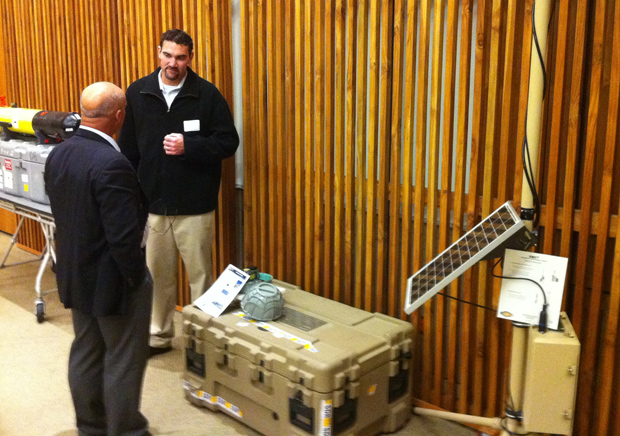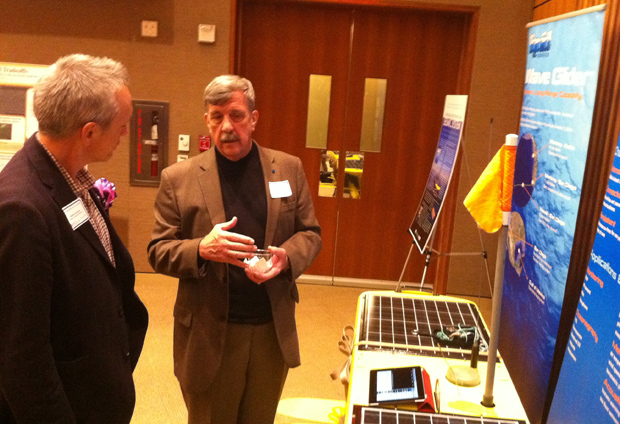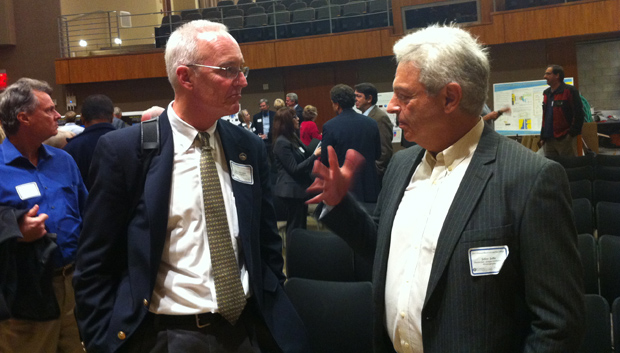
By:
- Robert Monroe
Published Date
By:
- Robert Monroe
Share This:
Science Frontiers Showcased at Scripps

From prediction of algal blooms that could poison seafood to identification of subseafloor oil deposits to an effort for the military to borrow camouflage techniques from octopi, the cross-section of research presented at Scripps Institution of Oceanography Jan. 19 ran the gamut from practical to fantastical.
Researchers presented a science showcase to Scripps supporters during a two-day meeting of institutional advisors. The emphasis was on projects from which society can derive direct benefit.
Melissa Carter, a researcher in the Integrative Oceanography Division at Scripps, related the story of harmful algal blooms studies at the institution, which have taken place almost as long as the 108-year-old Scripps has been in existence. She described to an audience of about 75 how blooms of algae like Alexandrium can wreak havoc on populations of shellfish, birds, and marine mammals. The microorganisms also pose practical barriers to understanding, though, said Carter, adding that scientists are still trying to understand why they produce toxins sometimes but not always.
“It’s like they’re trying to outsmart us,” she said.

Likewise, the search for oil requires the best thinkers and most innovative technology to support industries with trillions of dollars riding on decisions guided by science. Steve Constable, a professor of geophysics at Scripps, gave an overview of how seismic studies have allowed explorers to image layers of rock as deep as Earth’s mantle but how a technology pioneered at Scripps gives another way to look into the lithosphere. Electromagnetic surveying employs knowledge of everything from Earth’s magnetic field to the conductivity of the water within rock being subducted under tectonic plates to produce subsurface imagery that seismic surveys can miss. It is an alternative still in relative infancy compared to seismic studies but holds potential to help prevent costly unsuccessful drilling attempts.
Despite Scripps’ profile of climate change research, which has historically included warnings about continued use of fossil fuels, and recent oil exploration-related disasters such as the 2010 Deepwater Horizon spill involving longtime Scripps research supporter BP, Constable defended Scripps’ role in helping oil companies find reserves. He noted that the world is currently consuming 20 billion more barrels of oil per year than it discovers as new reserves and that further exploration is needed to help reduce the threat of societal instability that would be caused by a drop in liquid fuel availability before other fuels can be made economical. He also added that his relationship with oil companies has provided tens of millions of dollars toward technology development, basic research and student training, though he acknowledged that was a sum that may seem small compared to oil company revenues.

“It helps me with what I really want to do, which is to do science and train students,” he told the audience.
Oceanographer Jules Jaffe also related the thrill of immersing – in all senses of the word – students into ocean science. Jaffe led the audience on a tour of his lab’s ocean imaging technologies – from his work as a newly minted Ph.D. to aid the search for wreckage of the Titanic in the mid 1980s to his current endeavor to deploy a variety of microscopes in the ocean. The latter would enable views of microorganisms that now are diminished when specimens are removed from the sea and brought to labs for examination.
The straight-from-Popular-Science ideas in his lab don’t stop there, he said. His research team is also studying how the military could benefit from underwater camouflage techniques found in nature. The lab is attempting to understand how octopi, cuttlefish and other organisms manipulate their pigment in response to light to make themselves invisible to predators.
Share This:
You May Also Like
Stay in the Know
Keep up with all the latest from UC San Diego. Subscribe to the newsletter today.


